Lucian Freud
Lucian Michael Freud
Wikiart 有
簡介:Lucian Freud was a British artist, famous for his portraits and self-portraits painted in an expressive neo-figurative style. He was born in Berlin, the grandson of the revolutionary psychologist Sigmund Freud, and the son of an architect Ernst Freud and an art historian Lucie Brasch.
Freud’s representation in public was corresponding to the image of bohemian artist. Quite unruly to all the authorities, he was expelled from a few schools at an early age, and later on, his reckless behavior was said to be the cause of the fire in one of the schools. He drew
attention to himself wherever he went with his companion - a pet hawk on his wrist or shoulder. Freud used to spend days going to diners, gambling, and spending time in the company of the British aristocrats, socialites, and artists. Among them was the painter Francis Bacon, who was greatly affecting Freud’s work - until an end of their friendship, which was inevitable having in mind their characters and a lack of respect for each other’s later work.
Freud belonged to the School of London, a group of artists dedicated to figurative painting. This approach was highly controversial to an art world which, at that time, was dominated by abstraction. Compared with other prominent painters of that school - David Hockney, or Francis Bacon - Freud was stylistically a more conventional artist. He painted people without idealizing them, emphasizing sexual characteristics and imperfections of a human body. In his paintings, he used to describe unease or somehow disturbed mental conditions of specific individuals, but also of humans in general.
Influenced by early 20th-century Expressionism, Freud’s wide, textured strokes evoke the art of Edvard Munch and Egon Schiele. His anthropomorphic depictions of objects such as chairs, shoes, etc., as well as his tilted perspective, reminds us of Vincent van Gogh’s style. By the end of 1960s, Freud’s strokes became heavier and more layered. His style changed towards recognizable expressive naked portraits, which represented deformed and unpleasant bodies. Later on, during the 1980s and 1990s, when he became increasingly popular, Freud made portraits of many famous subjects - an art critic Martin Gayford, an artist David Hockney, and the British Queen Elizabeth II. Freud is also famous for his self-portraitists which he painted obsessively. He had been making them persistently for over six decades, which reminds us of the tradition of Rembrandt and Schiele. His self-portraits show deep introspection, detailed analysis of his facial expressions, and the emotions behind them.
Once he established his recognizable style, Freud didn’t change it until the end of his artistic career. His long and tiring sessions with his sitters could be compared to the psychoanalytic practice of his grandfather. Freud challenged conventions of portraiture and inspired a new generations of painters, such as John Currin or Eric Fischl.
283張Lucian Freud的畫
LUCIAN FREUD FAMOUS WORKS
VIEW ALL 283 ARTWORKS
3/4 Great Artists in Their Own Words - But Is it Art ? (1966-1993)
LUCIAN FREUD FAMOUS WORKS
https://www.youtube.com/watch?v=Kc8BS1WIgGA
The Metropolitan Museum of Art, New York
Happy birthday to Lucian Freud, born on this day in 1922. As one of Britain's leading realist painters, Freud's compositions focus on the human figure and face, often revealing the humanity of his subjects while depicting their physical ugliness.
Lucian Freud (British (born Germany), 1922–2011) | Naked Man, Back View | 1991–92
"Flesh is the reason why oil painting was developed."
METMUSEUM.ORG
Tate
"The painter's obsession with his subject is all that he needs" Happy birthday Lucian Freud! http://ow.ly/VzfOx
Lucian Freud (British (born Germany), 1922–2011) | Naked Man, Back View | 1991–92
"Flesh is the reason why oil painting was developed."
METMUSEUM.ORG
Tate
"The painter's obsession with his subject is all that he needs" Happy birthday Lucian Freud! http://ow.ly/VzfOx
Lucian Freud, Who Recast Art of Portraiture, Dies at 88
By WILLIAM GRIMES
Published: July 21, 2011
Lucian Freud, whose stark and revealing paintings of friends and intimates, splayed nude in his studio, recast the art of portraiture and offered a new approach to figurative art, died on Wednesday night at his home in London. He was 88.
Stephan Agostini/Agence France-Presse — Getty Images
Lucian Freud in 2010 More Photos »
Multimedia
Thyssen-Bornemisza Collection, Madrid/Bridgeman Art Library
"Reflection with Two Children (Self Portrait), " 1965 by Lucian Freud. More Photos »
Readers’ Comments
Share your thoughts.
Mr. Freud, a grandson of Sigmund Freud and a brother of the British television personality Clement Freud, was already an important figure in the small London art world when, in the immediate postwar years, he embarked on a series of portraits that established him as a potent new voice in figurative art.
In paintings like “Girl With Roses” (1947-48) and “Girl With a White Dog” (1951-52), he put the pictorial language of traditional European painting in the service of an anti-romantic, confrontational style of portraiture that stripped bare the sitter’s social facade. Ordinary people — many of them his friends and intimates — stared wide-eyed from the canvas, vulnerable to the artist’s ruthless inspection.
From the late 1950s, when he began using a stiffer brush and moving paint in great swaths around the canvas, Mr. Freud’s nudes took on a new fleshiness and mass. His subjects, pushed to the limit in exhausting extended sessions, day after day, dropped their defenses and opened up. The faces showed fatigue, distress, torpor.
The flesh was mottled, lumpy and, in the case of his 1990s portraits of the performance artist Leigh Bowery and the phenomenally obese civil servant Sue Tilley, shockingly abundant.
The relationship between sitter and painter, in his work, overturned traditional portraiture. It was “nearer to the classic relationship of the 20th century: that between interrogator and interrogated,” the art critic John Russell wrote in “Private View,” his survey of the London art scene in the 1960s.
William Feaver, a British critic who organized a Freud retrospective at Tate Britain in 2002, said: “Freud has generated a life’s worth of genuinely new painting that sits obstinately across the path of those lesser painters who get by on less. He always pressed to extremes, carrying on further than one would think necessary and rarely letting anything go before it became disconcerting.”
Lucian Michael Freud was born in Berlin on Dec. 8, 1922, and grew up in a wealthy neighborhood near the Tiergarten. His father, Ernst L. Freud, an architect who was Sigmund Freud’s youngest son, married Lucie Brasch, the heiress to a timber fortune, and the family enjoyed summers on the North Sea and visits to a family estate near Cottbus.
In 1933, after Hitler came to power, the Freuds moved to London, where Lucian attended progressive schools but showed little academic promise. He was more interested in horses than in his studies, and entertained thoughts of becoming a jockey.
In 1938, he was expelled from Bryanston, in Dorset, after dropping his trousers on a dare on a street in Bournemouth. But his sandstone sculpture of a horse earned him entry into the Central School of Arts and Crafts in London. He left there after a year to enroll in the East Anglian School of Drawing and Painting in Dedham, where he studied with the painter Cedric Morris. While it is true that the school burned to the ground while he was there, the often repeated story that Mr. Freud accidentally started the fire with a discarded cigarette seems unlikely.
In 1941, hoping to make his way to New York, Mr. Freud enlisted in the Merchant Navy, where he served on a convoy ship crossing the Atlantic. He got no nearer to New York than Halifax, Nova Scotia, and after returning to Liverpool developed tonsillitis and was given a medical discharge from the service.
Mr. Freud was a bohemian of the old school. He set up his studios in squalid neighborhoods, developed a Byronic reputation as a rake and gambled recklessly (“debit stimulates me,” he once said). In 1948, he married Kitty Garman, the daughter of the sculptor Jacob Epstein, whom he depicted in several portraits, notably “Girl With Roses,” “Girl With a Kitten” (1947) and “Girl With a White Dog” (1950-51). That marriage ended in divorce, as did his second marriage, to Lady Caroline Blackwood. He is survived by many children from his first marriage and from a series of romantic relationships.
His early work, often with an implied narrative, was strongly influenced by the German Neue Sachlichkeit (New Objectivity) painters like Georg Grosz and Otto Dix, although his influences reached back to Albrecht Dürer and the Flemish masters like Hans Memling.
On occasion he ventured into Surrealist territory. In “The Painter’s Room” (1943), a zebra with red and yellow stripes pokes its head through the window of a studio furnished with a palm tree and sofa. A top hat sits on the floor.
Mr. Freud later rejected Surrealism with something like contempt. “I could never put anything into a picture that wasn’t actually there in front of me,” he told the art critic Robert Hughes. “That would be a pointless lie, a mere bit of artfulness.”
A decisive influence was Francis Bacon, a fellow artist at the 1954 Venice Biennale and the subject of one of his most famous works, a head painted in oil on copper in 1952. Bacon’s free, daring brushwork led Mr. Freud to abandon the linear, thinly painted portraits of the 1940s and move toward the brushy, searching portrait style of his mature work, with its severely muted palette of browns and yellows.
“Full, saturated colors have an emotional significance that I want to avoid,” he once said. To the artist and Freud biographer Lawrence Gowing, he said, “For me the paint is the person.” Mr. Freud’s dingy studio became his artistic universe, a grim theater in which his subjects, stripped bare and therefore unidentifiable by class, thrust into contorted positions, submitted to the artist’s unblinking, merciless inspection.
The sense of the artist-model relationship is suggested by “Reflection With Two Children,” a 1965 self-portrait showing Mr. Freud seen from below, the vantage point of a dog looking at its master. Two children, almost miniature in scale, are shunted to the side of the canvas. A glaring light overhead contributes to the impression of the artist as all-powerful inquisitor.
His female subjects in particular seemed not just nude but obtrusively naked. Mr. Freud pushed this effect so far, Mr. Russell once noted “that we sometimes wonder if we have any right to be there.” By contrast, his horses and dogs, like his whippets Pluto and Eli, were evoked with tender solicitude.
“I’ve got a strong autobiographical bias,” he told Mr. Feaver, the British critic. “My work is entirely about myself and my surroundings.”
On rare occasions Mr. Freud took on something akin to official portraits. He painted the collector Hans Heinrich Thyssen-Bornemisza, fully clothed, in "Man in a Chair" (1985). His stern 2001 portrait of Queen Elizabeth, showing the royal head topped by the Diamond Diadem, divided the critics and public.
Some critics hailed the picture as bold, uncompromising and truthful. Arthur Morrison, the arts editor of The Times of London, wrote, “The chin has what can only be described as a six-o’clock shadow, and the neck would not disgrace a rugby prop forward.” The newspaper’s royal photographer said Mr. Freud should be thrown into the Tower of London.
These were deviations. Much more in the Freud vein was his portrait of a man sprawled on a couch holding a dormant rat (“Naked Man With Rat,” 1977-78). The animal’s tail, draped across the model’s left thigh, nearly makes contact with his genitals, producing an ineffably creepy effect.
Mr. Freud remained deeply unfashionable in the United States for many decades, but in 1987 the Hirshhorn Museum in Washington exhibited his work in a show that no New York museum would take on. This was a watershed event. Mr. Hughes proclaimed him “the greatest living realist painter,” and a Freud cult soon developed. In 1993 the Metropolitan Museum of Art organized a retrospective of his work.
“It is an attempt at a record,” Mr. Freud said, describing his work on the occasion of his retrospective at the Hayward Gallery in 1974. “ I work from the people that interest me and that I care about, in rooms that I live in and know.”
It took 9 months to complete. Ah, imagine the numb bum!
http://bbc.in/1UK4ZB8
http://bbc.in/1UK4ZB8
| |||||
| |||||
| |||||
| |||||
| |||||
|
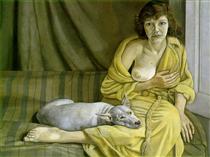
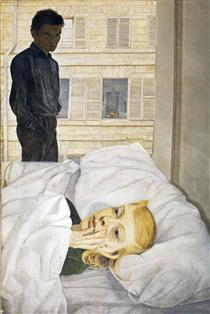
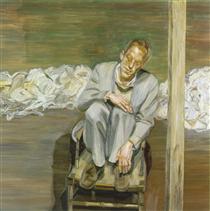
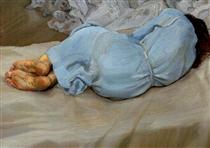
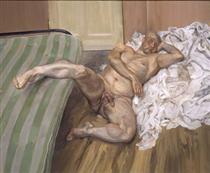
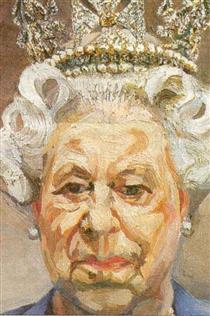
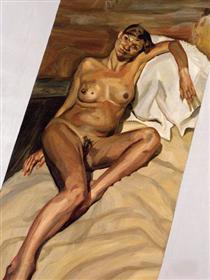







沒有留言:
張貼留言